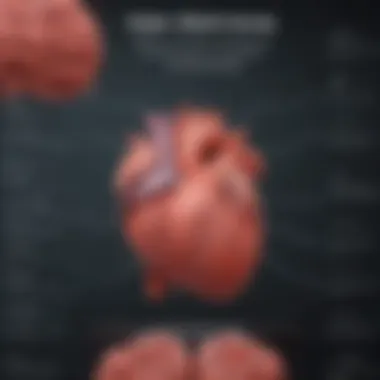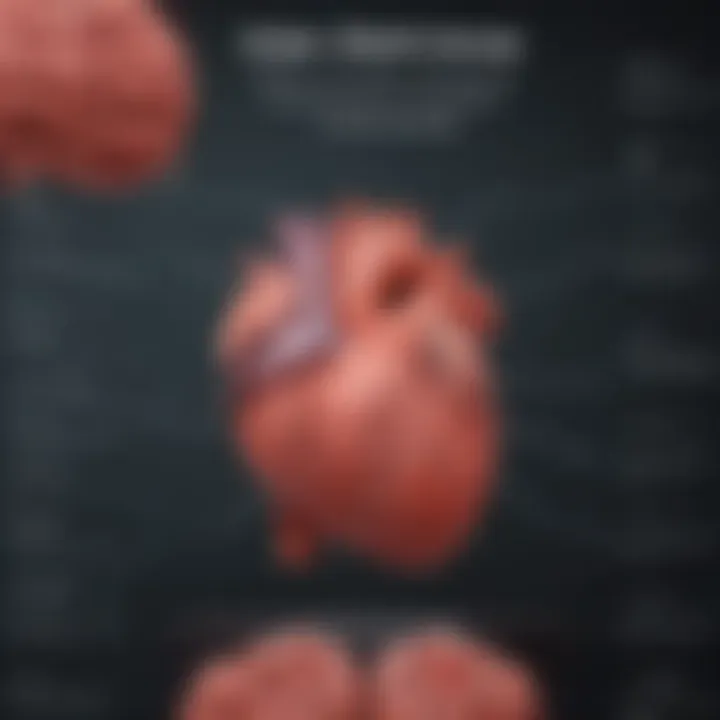Understanding Acute Cardiomyopathy: Causes and Management


Intro
Acute cardiomyopathy is a critical condition characterized by sudden cardiac muscle dysfunction. Health professionals often encounter acute cardiomyopathy in various patient populations, making understanding this condition essential for effective management. This article aims to dissect the underlying causes, diagnostic methods, and treatment strategies associated with acute cardiomyopathy. Addressing these elements involves exploring both ischemic and non-ischemic origins, thereby highlighting the complexity of this disorder.
Research Overview
Key Findings
Recent studies demonstrate that acute cardiomyopathy can arise from various etiologies, including but not limited to.
- Ischemic events such as myocardial infarction
- Inflammatory processes, like myocarditis
- Toxic exposures, including alcohol and specific medications
Identifying these factors is crucial since they result in different management approaches and patient outcomes. Furthermore, there is significant evidence showing that timely intervention can lead to better prognoses in affected patients. Understanding these key findings forms the basis upon which ongoing research and clinical practices are built.
Study Methodology
Most of the research conducted on acute cardiomyopathy employs a combination of retrospective analyses and prospective cohort studies. These studies utilize clinical data from hospitals that provide acute care. Clinical trials testing novel therapies and examining patient response to existing treatments are also integral components of this research landscape. By analyzing large populations with diverse backgrounds, researchers obtain a clearer picture of the varied presentations and potential outcomes associated with acute cardiomyopathy.
Background and Context
Historical Background
Cardiomyopathy has been a recognized medical condition for over a century. The term "cardiomyopathy" includes a group of diseases that affect the heart muscle. Acute manifestations, however, have only recently been the focus of intense study due to increasing hospital admissions directly linked to cardiomyopathy. As clinical understanding deepened, the spectrum of causes became apparent, leading to improved classification systems.
Current Trends in the Field
Recent advancements in medical imaging and biomarker discovery have significantly enhanced the diagnosis of acute cardiomyopathy. For example, the use of cardiac magnetic resonance imaging (MRI) has provided deeper insights into structural abnormalities. Moreover, the identification of specific myocardial markers in blood tests allows for quick, accurate diagnoses.
The focus on personalized medicine is also on the rise in this field, with treatment plans tailored to the individual characteristics of patients. Given these ongoing developments, the landscape of acute cardiomyopathy continues to evolve rapidly, necessitating an adaptable approach to both research and clinical practice.
In summary, understanding the myriad causes, diagnostic approaches, and treatment pathways in acute cardiomyopathy is key in optimizing patient care. This approach bridges the gap between theoretical knowledge and practical application in diverse healthcare settings.
Defining Acute Cardiomyopathy
Acute cardiomyopathy stands as a critical subset of cardiomyopathies, primarily marked by its sudden onset and potential for rapid deterioration. Understanding this condition is essential for clinicians and researchers alike, as it often presents with severe symptoms that can lead to significant morbidity and mortality. Distinguishing acute cardiomyopathy from other cardiac conditions is vital since it impacts treatment approaches and clinical outcomes.
One aspect of defining acute cardiomyopathy revolves around its clinical characteristics. These include the degree of impairment in cardiac function, which can arise from various underlying causes. This definition enriches the discussion surrounding not only the manifestations of the disease but also its broader epidemiological implications. A precise understanding of acute cardiomyopathy helps in the early recognition and timely intervention, which are crucial in improving patient outcomes.
Characteristics and Symptoms
The characteristics of acute cardiomyopathy often surface suddenly and can vary greatly among individuals. Key symptoms generally include:
- Chest Pain: Often described as sharp or squeezing, it may indicate myocardial ischemia.
- Shortness of Breath: This can occur at rest or during activity, signaling impaired heart function.
- Fatigue: A common symptom, reflecting reduced cardiac output and systemic perfusion.
Other manifestations may also include palpitations, lightheadedness, or syncope. These symptoms raise concern for acute cardiac events and necessitate immediate medical evaluation. The rapid assessment of symptoms plays a pivotal role in diagnosing and managing this condition effectively.
Acute vs. Chronic Cardiomyopathy
Differentiating between acute and chronic cardiomyopathy is critical for appropriate management strategies. Acute cardiomyopathy is characterized by a sudden onset of symptoms, often associated with identifiable triggers, such as viral infections, drug toxicity, or acute ischemic events. In contrast, chronic cardiomyopathy involves gradual progression, often related to long-standing conditions like hypertension or valvular disease.
The implications of this difference are profound:
- Management Strategies: Acute cardiomyopathy may require immediate stabilization, while chronic cases may allow for gradual adjustment of therapies.
- Prognosis: Acute cases can culminate in significant recovery or deterioration, while chronic cases typically involve ongoing management of symptoms.
Recognizing these distinctions not only aids clinicians in formulating treatment plans but also ensures that patients receive tailored care based on their specific disease state.
Pathophysiology of Acute Cardiomyopathy
The pathophysiology of acute cardiomyopathy is crucial for understanding the underlying mechanisms of the condition. It encompasses the cellular and systemic changes that contribute to myocardial dysfunction. Recognizing these processes aids clinicians in diagnosing and managing the condition effectively. Understanding the pathophysiological changes can lead to better therapeutic strategies and improve patient outcomes.
Cellular Mechanisms
In acute cardiomyopathy, cellular mechanisms play a pivotal role. These processes include alterations in cellular signaling pathways, which can lead to cardiomyocyte injury and death. Key aspects of this cellular pathology include:
- Calcium Handling: Disruption in intracellular calcium levels can result in impaired contractility and rhythm disturbances. Abnormal calcium signaling is often a hallmark of cardiac dysfunction.
- Apoptosis and Autophagy: Excessive cardiomyocyte apoptosis contributes to the loss of functional myocytes, compromising heart performance. Conversely, autophagy might be upregulated in an attempt to remove damaged proteins and organelles, but can become maladaptive.
- Metabolic Dysregulation: Myocardial energy metabolism shifts from aerobic to anaerobic pathways, resulting in inefficient energy utilization. This metabolic change can exacerbate cardiac function impairment.
These cellular mechanisms collectively contribute to the clinical manifestation of acute cardiomyopathy, including heart failure and arrhythmias.
Inflammatory Responses
Inflammatory responses are another critical aspect of acute cardiomyopathy pathophysiology. An immune response can be triggered by various insults, whether infections or toxins. Key features include:
- Cytokine Release: Pro-inflammatory cytokines such as TNF-alpha and interleukins are released during myocardial injury. These molecules can lead to further myocardial damage and exacerbate inflammation.
- Immune Cell Infiltration: In acute scenarios, immune cells such as macrophages can infiltrate the myocardium. Their presence is essential for tissue repair but may exacerbate injury through their pro-inflammatory actions.
- Vascular Effects: Inflammation affects vascular integrity, leading to increased vascular permeability and contributing to edema. This can worsen cardiac output and lead to complications.
Understanding these inflammatory processes allows for the development of targeted therapies that may mitigate damage and promote recovery. The interplay between cellular injury and the immune response is complex, necessitating a multifaceted approach to treatment.
Classification of Acute Cardiomyopathy
Understanding the classification of acute cardiomyopathy is crucial for medical professionals, researchers, and educators. It helps in establishing a clear framework for diagnosing, managing, and researching this condition. Classifying acute cardiomyopathy enables healthcare providers to tailor treatment strategies and improve patient outcomes. This classification is based on the underlying causes, allowing for more precise and effective medical interventions.


Ischemic Cardiomyopathy
Ischemic cardiomyopathy arises from inadequate blood flow to the heart muscle, often due to coronary artery disease. This lack of supply leads to myocardial dysfunction. The primary factor here is ischemia, which can result from a heart attack, leading to irreversible damage. Symptoms may include chest pain, shortness of breath, and fatigue—exactly those present in acute situations.
Diagnosis involves imaging techniques such as echocardiography and MRI to visualize heart function and assess damage. Addressing ischemic cardiomyopathy often requires interventions like angioplasty or stenting. These methods restore blood flow, which can significantly improve heart function and overall patient health.
Non-Ischemic Cardiomyopathy
Non-ischemic cardiomyopathy refers to cases where myocardial dysfunction occurs without ischemic causes. This classification encompasses a wide array of factors, including genetic issues, infections, and autoimmune diseases. Conditions such as dilated cardiomyopathy and hypertrophic cardiomyopathy fall under this category and have distinct etiologies.
Management of non-ischemic cardiomyopathy may vary. It often includes pharmacological treatments to improve cardiac efficiency and lifestyle modifications to mitigate risks. The diversity in causes emphasizes the importance of thorough patient history and extensive diagnostic testing.
Acute Viral Myocarditis
Acute viral myocarditis is characterized by inflammation of the myocardium, typically following a viral infection. Viruses like Coxsackievirus and influenza are common culprits. Patients may present with symptoms similar to those of heart failure, including fatigue and shortness of breath. Recognizing this type is crucial, as early intervention might prevent progression to heart failure.
Diagnosis often relies on serological testing and imaging, helping clinicians identify viral involvement. Management can be complex, often necessitating a holistic approach that includes antiviral therapies along with symptomatic treatment. Long-term follow-up is also critical, as some patients may develop chronic cardiomyopathy due to initial viral infections.
The classification schemes for acute cardiomyopathy not only guide treatment but also inform research directions and increase understanding of this multifaceted condition.
In summary, the classification of acute cardiomyopathy plays a pivotal role in effectively addressing this clinical challenge. It shapes the way cardiologists can respond to acute presentations and informs ongoing research that seeks better treatment options.
Etiological Factors
Understanding the etiological factors of acute cardiomyopathy is crucial for clinicians and researchers alike. These factors refer to the underlying causes that can trigger the condition, and recognizing them is essential for accurate diagnosis and effective management. An awareness of the various etiological elements enables healthcare professionals to implement targeted treatment plans, improving patient outcomes. This section will explore multiple categories of etiological factors, including infectious agents, toxic exposures, and genetic predispositions.
Infectious Agents
Infectious agents play a significant role in the development of acute cardiomyopathy. Viral infections, particularly those that lead to inflammation of the myocardium, are known contributors. Among the various viruses, the Coxsackie B virus is frequently implicated. Damage caused by these infections can disrupt cardiac function, leading to symptoms such as fatigue and shortness of breath.
It is crucial to identify the specific viral agents involved, as this can influence the treatment approach. For example, supportive care is often sufficient for viral myocarditis, while more severe cases may require advanced interventions.
Toxic and Drug-Induced Cardiomyopathy
Toxic and drug-induced cardiomyopathy represents another vital category of etiology. Several substances can cause myocardial injury, resulting in acute cardiomyopathy. Common culprits include alcohol, certain chemotherapy agents, and illegal drugs such as cocaine.
The mechanisms through which these agents exert their effects can vary. For example, alcohol may lead to direct toxic effects on cardiac muscle cells, while chemotherapy drugs can cause myocardial damage through oxidative stress. A careful history of substance use is important in identifying potential causes in patients presenting with cardiac dysfunction.
Genetic Predispositions
Genetic predispositions can significantly influence the risk of developing acute cardiomyopathy. Certain hereditary conditions and mutations can render individuals more susceptible to myocardial dysfunction. For instance, conditions like hypertrophic cardiomyopathy often have genetic components that may present as acute symptoms under stress or other triggering factors.
A comprehensive family history evaluation is relevant in these cases, as it can uncover potential hereditary links. Genetic testing may also be considered to identify specific mutations responsible for cardiomyopathy. Understanding these predispositions aids in risk assessment and tailored management strategies for affected individuals.
Clinical Presentation
Clinical presentation is a fundamental aspect of understanding acute cardiomyopathy. Recognizing the symptoms and conducting thorough physical examinations can lead to timely diagnosis and effective management. This section delves into the common symptoms and examination findings associated with acute cardiomyopathy, emphasizing their significance in clinical practice.
Symptoms Overview
Chest Pain
Chest pain is a prominent symptom of acute cardiomyopathy. Patients often describe it as a pressure, tightness, or sharp feeling in the chest region. The significance of chest pain lies in its ability to signal an underlying cardiac issue. Clinicians often prioritize assessing this symptom as it can indicate serious complications such as ischemia or heart failure. One unique feature of chest pain in this context is that it may not always correspond to the severity of the cardiac condition, which means thorough evaluation is necessary. While it is a critical symptom, its variability can complicate diagnosis in some cases.
Shortness of Breath
Shortness of breath, or dyspnea, frequently accompanies cardiac anomalies, including acute cardiomyopathy. It typically arises due to inefficient heart functioning and can manifest at rest or during physical activity. This symptom is especially pertinent in patients with decreased cardiac output, making it an effective indicator for assessment. Shortness of breath generally highlights the degree of heart impairment and its impact on everyday life. Its unique feature is that it can vary significantly; some patients may experience mild breathlessness, while others face severe limitations. Understanding this variability is essential for effective patient management.
Fatigue
Fatigue is another major symptom related to acute cardiomyopathy. Patients often report experiencing a profound sense of tiredness that does not improve with rest. Fatigue in this context is indicative of the heart's inability to provide sufficient blood flow, leading to reduced energy throughout the body. It is a common but often overlooked symptom that may not seem dramatic but can significantly affect quality of life. The unique aspect of fatigue is its insidious nature, which can develop gradually and may not be immediately recognized as a sign of cardiac trouble. Addressing fatigue is vital for improving patient outcomes and overall well-being.
Physical Examination Findings
Physical examination plays a crucial role in diagnosing acute cardiomyopathy. Clinicians look for specific signs that may indicate heart dysfunction. Common findings may include:
- Elevated jugular venous pressure, which suggests fluid overload.
- Abnormal heart sounds, including gallops or murmurs, that may indicate underlying issues.
- Peripheral edema, which is swelling in the limbs due to fluid retention.
These findings combined with thorough symptom assessments provide valuable insights into a patient's condition.
Understanding the clinical presentation of acute cardiomyopathy can enable earlier interventions and improve patient outcomes significantly.
Diagnostic Approaches
The diagnostic approaches to acute cardiomyopathy are critical in determining the underlying causes and guiding treatment strategies. These methods are vital as they offer clinicians the means to assess cardiac function and evaluate the presence of any structural abnormalities. Early and accurate diagnosis can significantly improve patient outcomes. This section discusses imaging techniques and laboratory tests that play an essential role in diagnosing acute cardiomyopathy.
Imaging Techniques
Imaging tools are available for the evaluation of the heart's structure and function. They provide important insights into the cardiac issues present, helping to establish a diagnosis swiftly.


Echocardiography
Echocardiography is often the first-line imaging modality employed in cases of suspected acute cardiomyopathy. It uses ultrasound waves to create a detailed image of the heart's chambers, valves, and overall function. One key characteristic of echocardiography is its ability to assess both left and right ventricular function. This non-invasive technique is favored because it provides real-time images and can evaluate blood flow patterns.
The unique feature of echocardiography is its capability to visualize heart motion during the cardiac cycle, allowing detection of regional wall motion abnormalities. One major advantage is the absence of radiation exposure to patients. However, the accuracy can be limited in some cases, particularly in obese patients or when there is excessive lung interference.
MRI
Magnetic Resonance Imaging (MRI) has emerged as a powerful tool for cardiac evaluation. Its primary contribution lies in providing high-resolution images of the cardiac muscle and surrounding structures. MRI's key characteristic is its ability to differentiate between types of myocardial tissue, such as scar and healthy tissue, providing deeper insights into the cardiomyopathy type.
One unique feature of MRI is its capability to assess myocardial edema and inflammation. This strength makes it particularly beneficial for diagnosing acute cases linked to myocarditis. However, the drawbacks include longer scan times and challenges in claustrophobic patients.
CT Scans
Computed Tomography (CT) scans are less frequently used but have value in specific situations. CT imaging is particularly beneficial in evaluating coronary artery disease, which can be a contributing factor in ischemic cardiomyopathy. The key characteristic of CT scans is their rapid acquisition time and the ability to quickly assess coronary arteries.
The unique feature of a CT scan is its ability to deliver detailed images of coronary anatomy and related structures. However, the primary disadvantage is the exposure to ionizing radiation, which raises concerns for patients requiring multiple imaging studies.
Biomarkers and Laboratory Tests
Biomarkers and laboratory tests assist in confirming the diagnosis of acute cardiomyopathy by providing objective measures of cardiac injury and function. These tests evaluate specific proteins and hormones released into the bloodstream in response to cardiac stress.
Troponins
Troponins are proteins released into the bloodstream when the heart muscle is damaged. Their measurement is crucial for diagnosing myocardial injury and distinguishing acute cardiomyopathy from other causes of chest pain. The defining characteristic of troponins is their high specificity for cardiac injury, making them reliable markers for diagnosis.
One unique feature of troponins is their capacity to remain elevated for several days after an acute event, allowing for diagnosis even after the onset of symptoms. The advantage is their ability to provide important information on the timing and extent of myocardial damage. A possible downside is their elevation in conditions other than cardiomyopathy, which can lead to diagnostic confusion.
BNP
B-type Natriuretic Peptide (BNP) is another crucial biomarker in the assessment of heart failure and cardiomyopathy. BNP levels rise in response to increased cardiac wall stress associated with heart failure. The key characteristic of BNP testing is its ability to reflect the severity of heart dysfunction.
The unique feature of BNP is its role in guiding therapeutic decisions and predicting outcomes in patients with acute cardiomyopathy. As a result, it is commonly used in emergency settings. However, BNP can be influenced by other factors such as renal function and obesity, which may complicate its interpretation.
Management Strategies
Effective management strategies are essential for patients with acute cardiomyopathy. The integration of pharmacological and non-pharmacological approaches significantly influences patient outcomes. The management framework aims to alleviate symptoms, prevent complications, and enhance the quality of life for patients. This section delineates the methodologies employed, emphasizing their respective advantages and considerations critical for clinical practice.
Pharmacological Interventions
Pharmacological interventions are pivotal in managing acute cardiomyopathy. They aim to restore normal cardiac function and improve hemodynamics. Two primary classes used are ACE inhibitors and beta-blockers.
ACE Inhibitors
ACE inhibitors, or angiotensin-converting enzyme inhibitors, play a significant role in managing acute cardiomyopathy. Their primary function involves dilating blood vessels, which reduces the workload on the heart. This property makes ACE inhibitors particularly beneficial for patients presenting with heart failure symptoms. A key characteristic of these medications is their ability to lower blood pressure while enhancing cardiac output.
The unique feature of ACE inhibitors is their effect on neurohormonal pathways. By inhibiting the production of angiotensin II, they curtail the adverse remodeling of the heart muscle.
However, while ACE inhibitors are widely regarded for their benefits, they may exhibit side effects such as cough or elevated potassium levels, which require careful monitoring.
Beta-Blockers
Beta-blockers are another essential class of medications in the management of acute cardiomyopathy. These agents primarily work by blocking the effects of adrenaline on the heart, leading to a decrease in heart rate and myocardial oxygen demand. This characteristic proves especially advantageous for patients struggling with symptoms like tachycardia or hypertension.
The unique benefit of beta-blockers includes their capacity to improve survival rates in patients with heart failure. They provide long-term improvements in heart function and structural remodeling. However, a careful approach is necessary, as abrupt discontinuation can precipitate worsened symptoms or acute heart failure.
Non-Pharmacological Approaches
Non-pharmacological strategies are equally paramount in the holistic management of acute cardiomyopathy. These approaches focus on lifestyle changes and structured rehabilitation programs that foster recovery and enhance quality of life.
Lifestyle Modifications
Lifestyle modifications encompass various changes that can significantly impact patients' health outcomes. Key aspects include diet, physical activity, and stress management. A heart-healthy diet, rich in fruits, vegetables, and whole grains, can help mitigate symptoms associated with cardiomyopathy.
Additionally, reducing sodium intake is crucial for managing blood pressure. Regular exercise, under medical guidance, can strengthen the heart muscle and improve overall endurance levels.
While lifestyle modifications present substantial advantages, adherence remains a challenge for many patients. Continuous education and support systems are vital for ensuring success in these modifications.
Cardiac Rehabilitation
Cardiac rehabilitation provides a structured program designed to improve physical and emotional health in patients recovering from cardiomyopathy. This program typically integrates exercise training, education on heart-healthy living, and counseling to reduce stress.
A significant characteristic of cardiac rehabilitation is its tailored approach. Individualized programs address specific needs, considering the patient's current health status and personal goals.
The unique advantage of rehabilitation is its evidence-based design that significantly enhances functional capacity and quality of life. However, accessibility and insurance coverage can pose barriers, limiting participation in these beneficial programs.
Successful management of acute cardiomyopathy requires a multifaceted approach that combines pharmacological interventions with lifestyle modifications and rehabilitation strategies.
By recognizing the importance of both approaches, healthcare professionals can better address the needs of their patients, paving the way for optimized outcomes.


Emerging Research and Future Directions
Emerging research in acute cardiomyopathy is vital as it can reshape the understanding and management of this complex condition. It offers insights into novel therapies, better diagnostic tools, and the overall enhancement of patient care. The exploration in this field emphasizes the evolving nature of cardiovascular medicine, capturing interest from clinicians, researchers, and policy-makers alike.
Innovations in Treatment
Innovations in treatment are critical for advancing the management of acute cardiomyopathy. These advancements encompass both pharmacological and non-pharmacological strategies that reflect a more nuanced understanding of disease mechanisms. The following areas are particularly noteworthy:
- Targeted therapies: New drugs that target specific molecular pathways are being studied. These can provide more effective treatment options while minimizing adverse effects.
- Biomarker development: Identifying biomarkers which signal the severity of cardiomyopathy may enable early intervention, optimizing outcomes for patients.
- Telemedicine and remote monitoring: Innovations in technology allow for continuous health monitoring and real-time data collection, which can lead to timely adjustments in treatment plans.
Potential for Regenerative Medicine
Regenerative medicine holds significant promise in treating acute cardiomyopathy. This discipline focuses on repairing damaged heart tissue and restoring function. Stem cell therapy is a leading area of exploration, with studies demonstrating its potential to regenerate myocardial tissue. Another avenue is the use of gene editing technologies, which aim to correct genetic defects that contribute to cardiomyopathy.
Benefits of regenerative medicine include:
- Reduced reliance on transplant: It offers hope for those who cannot receive a heart transplant.
- Long-term solutions: These approaches could address the underlying issues rather than only treating symptoms.
- Personalized treatment: Tailoring therapies to individual patient profiles enhances the effectiveness of interventions.
Research in regenerative medicine presents a foundation for future breakthroughs that could entirely change the landscape of acute cardiomyopathy management.
Case Studies in Acute Cardiomyopathy Management
Understanding real-world applications of acute cardiomyopathy management can greatly enhance the clinical perspective. Case studies need to highlight significant individual instances where unique challenges arise. Analyses of such cases can provide insights into optimal therapeutic approaches, the role of multidisciplinary care, and the importance of patient-centered strategies. In teaching environments, case studies serve as learning tools, fostering critical thinking and problem-solving skills in students and professionals alike.
Evaluating case studies also allows for better appreciation of variations in patient responses to treatment. Different clinical presentations can reveal much about how acute cardiomyopathy affects diverse populations differently, which is essential for tailoring treatment to individual needs. Such discussions promote awareness of health disparities, guiding more equitable healthcare solutions.
"Case studies bridge the gap between theory and practice, showcasing the complexities involved in treating acute cardiomyopathy."
Case Study One: Viral Myocarditis
Viral myocarditis presents a unique subset of acute cardiomyopathy cases that require nuanced management strategies. One illustrative case involves a 32-year-old male who developed symptoms of chest pain, shortness of breath, and fatigue following a recent viral infection. Laboratory tests confirmed elevated troponin levels and an echocardiogram indicated left ventricular dysfunction.
Treatment began with supportive measures, focusing on stabilizing cardiac function while monitoring for arrhythmias. Specific antiviral therapy was not initiated, since the causative viral agent was unidentified. Instead, beta-blockers and ACE inhibitors were used to manage heart failure symptoms. After several days, the patient showed marked improvement, leading to gradual recovery. This case underscores the importance of recognizing viral myocarditis and initiating appropriate management in a timely manner.
Case Study Two: Toxic Cardiomyopathy
Consider another patient, a 58-year-old woman with a history of chronic alcohol use, who presented with acute dyspnea and palpitations. Clinical examination revealed significant heart enlargement on imaging studies, indicative of toxic cardiomyopathy. This diagnosis prompted a thorough review of her medication list and alcohol intake.
Management involved immediate cessation of alcohol, alongside heart failure treatment protocols including diuretics and beta-blockers. Ongoing evaluation included regular follow-ups to monitor cardiac function and abstinence from alcohol. After a committed rehabilitation approach, the patient's heart function showed considerable improvement. This case illustrates how lifestyle modifications can drastically alter the course of toxic cardiomyopathy, leading to improved patient outcomes.
Challenges and Barriers
The study and management of acute cardiomyopathy come with several challenges and barriers that can directly impact patient outcomes. Understanding these obstacles is crucial for healthcare professionals, researchers, and policymakers alike. These challenges include access to specialized care and health disparities that may affect various populations differently. Addressing these issues not only fosters a more effective management strategy but also ensures that all patients receive equitable care.
Access to Specialized Care
Access to specialized care is a significant hurdle in the management of acute cardiomyopathy. This condition often requires intervention from cardiologists and other specialized healthcare providers to ensure accurate diagnosis and appropriate treatment plans. However, many patients experience barriers such as:
- Geographic limitations: Patients living in rural areas may have difficulty reaching hospitals equipped to handle acute conditions.
- Financial constraints: The costs associated with advanced cardiac testing and treatment can be prohibitive for some patients, especially those without adequate insurance.
- Healthcare infrastructure: Not all healthcare facilities offer the necessary resources or expertise to manage acute cardiomyopathy effectively.
Given these factors, some patients may not receive timely treatment, leading to worsen outcomes. It is essential that healthcare systems work towards improving accessibility to specialized services, ensuring equitable care across demographics.
Health Disparities
Health disparities represent another critical barrier in the field of acute cardiomyopathy. Different populations often experience varying degrees of access to healthcare resources, influencing their treatment outcomes. Major factors contributing to these disparities include:
- Socioeconomic status: Individuals from lower-income backgrounds may struggle to afford timely medical care or transportation to specialized facilities.
- Race and ethnicity: Certain minority groups may face systemic bias in healthcare which can lead to delays in diagnosis and treatment.
- Education and health literacy: Lack of understanding regarding the symptoms and risks associated with cardiomyopathy may result in late presentation to healthcare services.
"Understanding social determinants of health can lead to more effective strategies to combat health disparities, particularly in acute cardiomyopathy."
Recognizing and addressing these health disparities is vital to ensure that all patients receive the necessary care to manage acute cardiomyopathy effectively. Efforts to improve education, outreach, and resource allocation can help bridge these gaps and improve patient outcomes overall.
The End
In addressing acute cardiomyopathy, it is essential to recognize its complexity and the depth of understanding required for effective management. This article encapsulates critical elements surrounding the condition, from its varied causes to diagnosis and management strategies.
One of the key benefits of understanding this topic is improved patient outcomes. Clinicians equipped with comprehensive knowledge of acute cardiomyopathy can make informed decisions. This leads to timely interventions, reducing morbidity and mortality across populations.
Moreover, this conclusion serves to highlight the multifaceted approach needed for proper management. It is vital to integrate medical and lifestyle factors into treatment plans. Each patient presents unique challenges and opportunities for personalized care.
Additionally, the call for continuous research is considerable. It is here where we can address gaps in knowledge and evolve our practices. Without ongoing inquiry, advancements in treatment options and diagnostic methods may stagnate. Such endeavors will foster better patient care worldwide, ultimately translating into improved health outcomes.
"The management of acute cardiomyopathy requires both precision in understanding and flexibility in approach to treatment."
Summary of Key Points
- Acute cardiomyopathy presents a significant clinical challenge.
- Understanding its nuances aids in effectively diagnosing and managing the condition.
- Key factors include recognizing unique patient profiles, underlying causes, and tailored approaches to therapy.
- The importance of continued research and innovation can’t be overstated in driving future treatment pathways.
The Need for Continued Research
The landscape of cardiomyopathy is dynamic, with new findings emerging regularly. Continued research into acute cardiomyopathy is crucial for multiple reasons. Firstly, it can lead to updated guidelines that incorporate the latest evidence-based practices.
Secondly, research facilitates the exploration of novel therapies and interventions. The development of biomarker tests is an example of how ongoing studies can lead to improved diagnostic accuracy.
Lastly, understanding the long-term outcomes associated with various management strategies can provide insights into optimizing care. A collaborative effort between researchers, clinicians, and patients can pave the way for significant breakthroughs in handling acute cardiomyopathy effectively.
In essence, investment in research is equivalent to investing in future healthcare quality, shaping a better tomorrow for patients.







